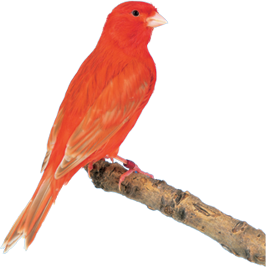Profiles
CANARY
(SerinusCaneru)
Family: Canary includes many varieties such as Yorkshire, Norwich, Gloucester – Corona (crest), consort (plain head), lizard, coloured canaries and roller canaries.
Origin: Wild canaries inhabit three groups of islands in the North Atlantic Ocean, the Canary Islands, the Madeira Islands and the Azures.
Size: 130mm to 170mm
Description:
The canary has evolved and mutated into many different sizes, shapes and colour varieties.
The original bird was green, now they are white, yellow, blue, cinnamon, slate, many varieties of fawn and some have crests. The plumage is close fitting to the body and silky smooth to the touch
Care:
A single bird can be kept in a cage with a skirt around the base because they can make an awful mess as they flick seed about looking for the seed they want to eat.
You can let these birds fly around the room, but the same rules apply as to any other bird loose in the home. All curtains should be drawn so they cannot fly into the windows, all pets should be kept outside, and if they can fly into the kitchen all stoves and appliances should be switched off and if they can go into the toilet or bathroom, the bath should be empty and the toilet seats should be down.
Canaries not only love the sun but they need to sunbathe to absorb the extra calcium intake they need but as with any pet never expose it to full sun and allow it to retreat to a shady spot within its cage or aviary.
These birds can frighten easily, in fact will die if fright is severe enough, and so cats and dogs should not be allowed to suddenly rush into the room or jump on or near aviary.
These birds also need to be kept away from any gas heaters and kitchen fumes, especially any fumes that are emitted from non-stick fry pans – these fumes are almost undetectable to people but to most birds they are quite toxic.
If birds are to be housed in an aviary, the aviary should have a window or open side facing north. The normal rules of cleanliness, fresh food and water applies.
Eats:
Good canary mix consisting of plain canary millets, rape and canola, linseed, niger, hulled oats and lettuce seed. Sprouted seeds are favoured during the breeding season. They also love to eat egg and biscuits, spinach, endives, lettuce, carrot, chickweed, apple, pear, melons, cherries, grapes, berries, and grit and cuttlefish bone needs to be supplied along with fresh water.
Features: The hen usually lays four to five eggs and incubates them for 13 days. Once the chicks hatch they cared for and fed for another 23 days and then once you see the chicks eating seed for themselves they should be taken away from the parents.
Call:
Canaries will respond with a “tweet” “tweet” whenever its owner approaches. The male will whistle away happily but during moult will not whistle as often.
Roller canaries are trained for singing and will often sing in a modulated, hollow tone and they are taught variations of tunes for competition purposes. This singing does not apply to pet birds.
The song of a “normal” canary is preferred as it can be readily heard (it sings with its beak open), the song of a roller canary is very soft and can only be heard when up close to the bird (it sings with a closed beak).
Personality
: This is a lively bird, but one that is also easily frightened and sensitive to fumes. It does not fuss over or seem to want any toys and it cannot be trained to talk.
